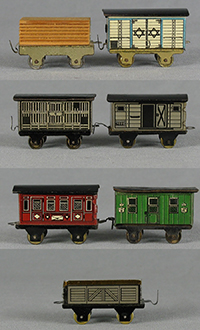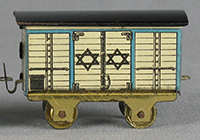 |
||||
|---|---|---|---|---|
| Hess 100 Set Without Tender, Circa 1920s Although not often seen, the Hess 100 locomotive without tender was also sold in sets. It did have a female coupler and the set was probably sold as an economy model. Not seen advertised, it is unknown how many multi-car combinations were offered. This set is mid-production defined by the solid serif “No. 100” identification. |
||||
 |
Hess 100 series passenger cars, different styles The 100 series train was produced from the late 1890s until the close of business in 1934. Three different graphic styles were used over this period of time. The oldest style is at far left, newest at far right. The construction changed slightly as the far left car’s body is fastened to the frame by a groove in the frame with side tabs in the body corner. The other two cars used tabs fastened through slots in the frame. Some early models had gold spirit varnished frames while most used black painted frames. |
|||
 |
Hess 100 series freight cars Different freight cars for the Hess 100 series train. First row: early production lumber wagon and goods wagon with Star of David, both circa 1900; Second row: early goods wagon circa 1900 and later goods wagon circa 1920s; Third row: mail wagons, red circa 1920s, green circa 1900; Fourth row: open gondola circa 1920s. |
|||
 |
Hess 100 Series Beer Wagon Marked with 6 Pointed Star, circa late 1890s Some have associated this star marked wagon with the Jews being transported by rail during the Nazi regime. If fact, this is a brewer’s star or zoigl, meaning that this wagon was used to transport beer. In Germany, the brewers used stars with 6 points, the origin ancient, and used long before the Jews adopted the Star of David. It was a sign of freshly brewed beer. During the Nazi era, brewers were forbidden from displaying the zoigl.
|
|||

.jpg)
